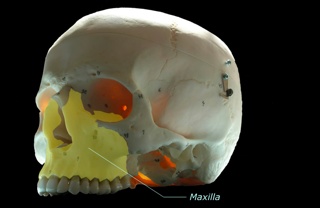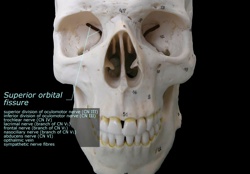
On Monday we went through the bones of the orbit, what the superior orbital fissure (and inferior orbital fissure and optic canal) were, and what went through it (and them).
To review the bones of the orbit look at these images. Hover over the bones to be reminded of their names. We also noted that the palatine bones just about reach up to the orbit, but you can’t see this on the images.

The superior orbital fissure is the slit in the posterior wall of the orbit. It passes through to the middle cranial fossa within the cranial cavity. The inferior orbital fissure is the slit in the floor of the orbit passing to the infratemporal fossa.
The superior orbital fissure is the main route for stuff to get from the brain to the orbit then. Everything in the orbit (muscles, glands, mucosa, skin, etc) will need to receive nerve fibres from cranial nerves passing through the superior orbital fissure. The optic nerve and the retina are the exceptions to this.
With regards to blood supply though, the ophthalmic artery passes through the optic canal with the optic nerve. It is a branch from the internal carotid artery and sends arterial branches out and around the orbit. The ophthalmic veins (there are superior and inferior opthalmic veins) do pass through the orbital fissures. Maybe a little counterintuitively the superior ophthalmic vein drains blood from the orbit back into the cranial cavity by passing through the superior orbital fissure. (The venous blood passes to the cavernous sinus on the other side and eventually leaves the cranial cavity through the internal jugular vein). This gives a route by which infection or drugs can pass intracranially from superficial structures, and will no doubt be mentioned a number of times in your studies. The inferior opthalmic vein connects to the pterygoid venous plexus of the face by sending branches through the inferior orbital fissure.
So what nerves pass through the superior orbital fissure? In essence, cranial nerves III, IV, V and VI. Easy, eh? Well, there’s a little more detail to it that you need to know.
CN III
Also known as the oculomotor nerve, this sends fibres to almost all of the muscles in the orbit (both extra-ocular and intra-ocular, i.e. the muscles of the lense and the constrictor muscle of the iris). It divides into superior and inferior branches before it emerges from the superior orbital fissure.
CN IV
Also known as the trochlear nerve (trochlea comes from the Greek word for “pulley”, and this is the nerve to a muscle that has a pulley) this is another motor nerve with the singular task of innervating the superior oblique muscle.
CN V
Here things get a little more complicated. Cranial nerve V is the trigeminal nerve, which divides into 3 branches within the cranial cavity: V1 (ophthalmic nerve), V2 (maxillary nerve) and V3 (mandibular nerve). These are the sensory nerves of the face (although you’ll remember that the mandibular nerve also sends some motor fibres to the muscles of mastication) and we’re interested in the ophthalmic nerve when we look at the orbit. Just before the ophthalmic nerve enters the superior orbital fissure it divides into 3 smaller nerves:
– frontal branch
– lacrimal branch
– nasociliary branch
So that’s a little inconvenient and tricky to remember. Note that some of these branches are rather interesting in function and in the other nerve fibres that they pick up that are not from the trigeminal nerve, but I won’t talk about that here.
CN VI
Last of all we have the abducent nerve (or abducens, whichever you prefer). The name of this nerve comes from its ability to abduct the eye, as it sends motor fibres to the lateral rectus muscle.
That’s about it for structures passing through the superior orbital fissure. Make sure that you can link all this up with what you learnt about the other parts of the orbit and the eye, and what you will learn about the functions of those structures.